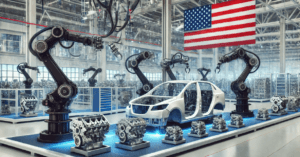Trump’s 25% Auto Tariff Shock: Major Blow to Indian Suppliers, But a Silver Lining?
U.S. President Donald Trump’s decision to impose a 25% tariff on imported vehicles and key auto components will hit Indian auto parts suppliers harder than car manufacturers. Since India does not export fully built cars to the U.S., automakers will face minimal impact. However, Indian auto component exports to the U.S. stood at $6.79 billion in FY24, and these new tariffs will make them significantly more expensive for American buyers. Industry experts believe this move could disrupt supply chains, particularly in engine components, powertrains, and transmissions, which form a major chunk of exports.
Despite the challenge, India’s cost-effective manufacturing could still give it a competitive edge in the global market. Some Indian suppliers, like the Motherson Group, have already set up manufacturing units in Mexico and Canada to leverage trade agreements and reduce tariff impact. The tariffs could also discourage Indian automakers from expanding into the U.S., especially in the electric vehicle segment. While industry bodies have yet to respond, experts suggest Indian suppliers will adapt to the changing landscape to retain their market position.

Trump’s 25% Auto Tariff Shock: Major Blow to Indian Suppliers, But a Silver Lining?
Indian auto parts manufacturers are likely to face sharper challenges than car producers due to new U.S. tariffs announced by former President Donald Trump, according to industry analysts. Starting in April, imported vehicles will attract a 25% duty, with an additional 25% levy on critical auto components like engines, transmissions, and electrical parts from May. These changes could disrupt India’s growing auto parts trade with the U.S., while car manufacturers remain relatively insulated.
Why Car Makers Escape the Worst
India’s automobile manufacturers export few fully built vehicles to the U.S., sparing them from direct impact. However, the auto components sector—which shipped $6.79 billion worth of parts to the U.S. in 2023–24—is vulnerable. Until now, these exports enjoyed minimal or zero import duties in the U.S., keeping prices competitive. The new tariffs could inflate costs for American buyers, potentially reducing demand for Indian-made parts.
Auto Parts Sector Under Pressure
Industry insiders warn that suppliers of engine parts, transmissions, and powertrains—key contributors to India’s exports—will feel the pinch. One executive, speaking anonymously, emphasized that the tariffs disproportionately target India’s strengths in these segments. Ravi G. Bhatia of JATO Dynamics India noted that while the tariffs aren’t aimed solely at India, the country’s suppliers must adapt quickly. “The sudden cost increase is a hurdle, but India’s reputation for affordable manufacturing could soften the blow,” he explained.
Electric Vehicle Ambitions at Risk
The tariffs cast a shadow over Indian automakers exploring entry into the U.S. market, particularly in electric vehicles (EVs). Companies like Mahindra & Mahindra and Tata Motors, which have shown interest in expanding their EV portfolios globally, may now face tougher calculations. Higher costs for components or finished vehicles could delay or scale back these plans, forcing firms to reassess their strategies.
Global Strategies Mitigate Risks
Some major Indian suppliers have already diversified their operations to counter such trade barriers. For instance, the Motherson Group, a leading auto parts manufacturer, operates plants in Mexico and Canada. These facilities, established under the North American Free Trade Agreement (NAFTA), allow the company to serve U.S. clients without incurring steep tariffs. Laksh Vaaman Sehgal, a director at Motherson International, highlighted their “globally local” approach: producing closer to customers reduces reliance on cross-border shipments. He added that gradual price adjustments across the industry could absorb some tariff impacts over time.
Uncertainty Looms for Smaller Suppliers
While large players like Motherson have buffers, smaller Indian suppliers without overseas facilities may struggle. Many lack the resources to set up foreign production lines or renegotiate contracts with U.S. buyers. Higher prices could push American companies to seek alternatives, such as sourcing from countries with lower tariffs or investing in local manufacturing.
Industry Bodies Stay Silent
Key organizations like the Automotive Component Manufacturers Association of India (ACMA) and the Society of Indian Automobile Manufacturers (SIAM) have not yet issued official statements. Their responses could influence government negotiations or policy adjustments. Meanwhile, suppliers are exploring workarounds, including cost-cutting measures, efficiency improvements, or passing partial costs to buyers.
Long-Term Adaptation
Experts believe India’s auto parts sector has the resilience to navigate these challenges. Decades of catering to global markets have honed their ability to adapt to shifting trade policies. Additionally, India’s cost advantage in labor and production remains intact, which could help retain price-sensitive customers. Bhatia stressed that while tariffs create short-term pain, suppliers might offset losses by targeting emerging markets or boosting domestic sales.
Looking Ahead
The tariffs underscore the volatility of international trade, urging Indian firms to prioritize flexibility. Diversifying export destinations, investing in innovation, and leveraging free-trade agreements could reduce future risks. For now, the industry’s focus is on minimizing disruptions while awaiting clarity on U.S. policy enforcement and potential retaliatory measures from other nations.
In summary, while Indian car makers face limited direct fallout, auto parts suppliers must brace for turbulence. Their ability to innovate, diversify, and leverage cost efficiencies will determine their survival in an increasingly protectionist global market.
You must be logged in to post a comment.